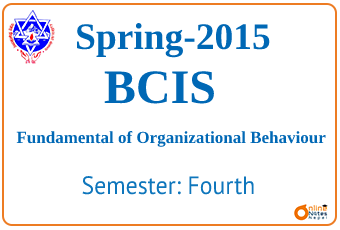Published by: sadikshya
Published date: 25 Jun 2021

This is the question set along with answers Fundamental of Organizational Behaviour Spring 2015, which was taken by the Pokhara University.
Pokhara University – Fundamental of Organizational Behaviour Spring 2015
| Level: Bachelor | Semester –Spring | Year: 2015 |
| Program: BBA/BBA-BI/BBA-TT/BCIS/BHCM | Full Marks: 100 | |
| Course: Fundamental of Organizational Behaviour | Pass Marks: 45 | |
| Time: 3hrs. | ||
Section “A”
Very Short Answer Questions
Attempt all the questions.
1. List any five area of contribution from sociology to the field of OB.
2. Differentiate between terminal and instrumental value
3. What do you mean by cognitive learning?
4. What do you mean by social loafing?
5. What is transactional analysis?
6. List out any four hygiene factors according to Hertzberg.
7. List out leadership style according to managerial grid with diagram.
8. Draw a diagram showing relation between performance and conflict.
9. Write any four ways to manage stress in an organization.
10. Mention any four characteristics of learning organization.
Section “B”
Descriptive Answer Questions
Attempt any six questions
11. Why the study of organizational behaviour is essential for today’s managers? Explain critical behavioural issues confronting the managers in using OB concept.
12. What are various theories of learning? Explain any two theories of learning with suitable examples.
13. Differentiate between group and work team. Explain the various stage of group formation, with suitable diagram and examples.
14. Are leadership and management different form one other? If so, how? Explain the fiedler’s contingency theory of leadership.
15. Discuss the organizational sources of stress? Explain in brief the organizational stress management strategies.
16. Define communication with its objectives. Explain the various steps involved in the communication process with a suitable diagram.
17. Explain Kurt Lewin’s process of organizational change. Why do people resist change? What measures can be taken to overcome resistance to change in organizations.
18.
Section “C”
Case Analysis
Read the scenario below and answer the questions that follow.
Mr.AlokBanarjee is the Chief Executive of a medium- sized pharmaceutical firm in Calcutta. He holds a Ph. D. in Pharmacy. However, he has not been involved in research and development of new products for two decades. Though turnover is not a problem for the company, Mr.Banarjee and his senior colleagues noticed that the workers on hourly basis are not working upto their full potential. It is well known fact that they filled their days with unnecessary and unproductive activities and worked only for the sake of a pay cheque. In the recent past the situation has become quite alarming as the organization began to disintegrate under the weight of uneconomical effort. The situation demanded immediate managerial attention and prompt remedial measures. Mr.Banarjee knew very well that the only way to progress and prosper is to motivate workers to peak performance through various incentive plans.
One fine morning, Mr.Banarjee contacted the Personnel Manager and enquired: “What is the problem with the workers on hourly basis? The wage bill shows that we pay them the highest in the industry. Our working conditions are fine. Our fringe benefits are excellent. Still these workers are not motivated. What do they require really?” The Personnel Manager gave the following reply: “I have already informed you a number of times, that money, working conditions and benefits are not enough. Other things are equally important. One of workers in that group recently gave me a clue as to why more and more workers are joining the bandwagon of ‘non-performers’. He felt bad that hard work and efficiency go un-noticed and un-rewarded in our organization. Our promotion and benefit plans are tied to length of service. Even the lazy workers, accordingly, enjoy all the benefits in the organization, which, in fact according to workers should go only to those who work hard.”
Mr.Banarjee then wanted the Personnel Manager to look into the problem more closely and find out a solution to the problem of workers on hourly basis.
Questions
a) Explain the motivational problem in this case by relating to Herzberg’s theory.
b) Analyze worker’s lack of motivation using Victor Vroom’s expectancy theory.
c) What would be your response to Banarjee’s statement, if you were the Personnel Manager of the Company?
d) If you were the manager, how would you motivate the employees so that they work better?